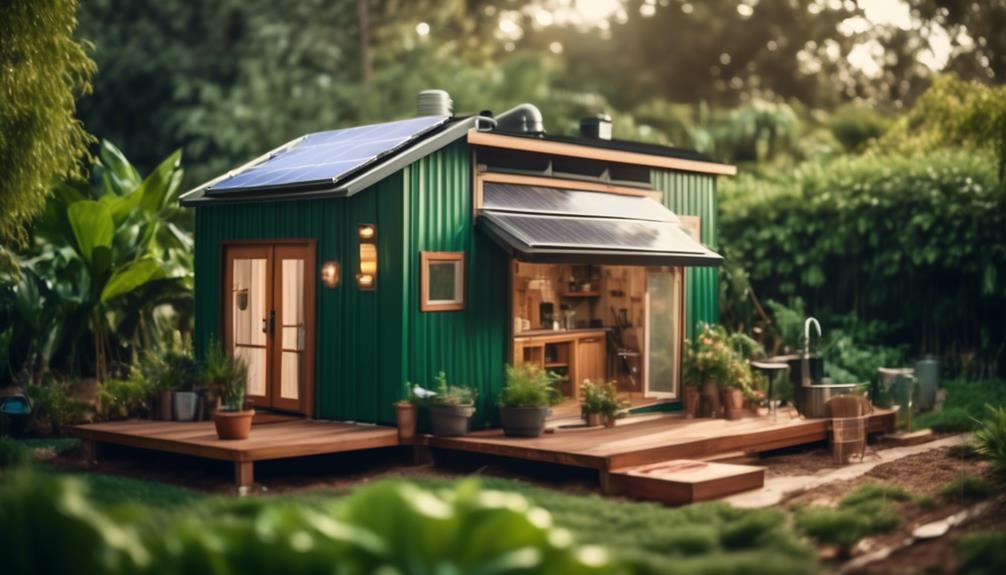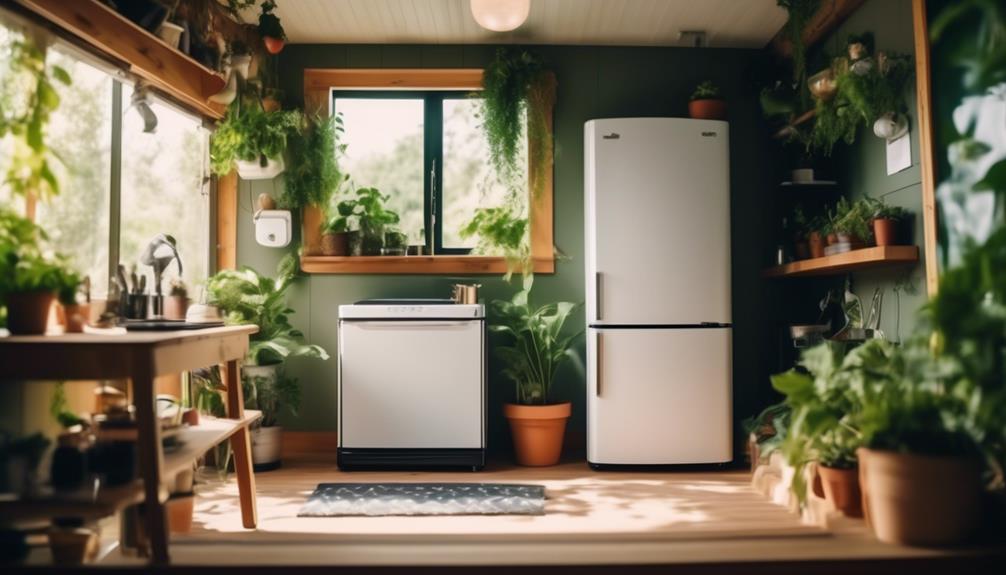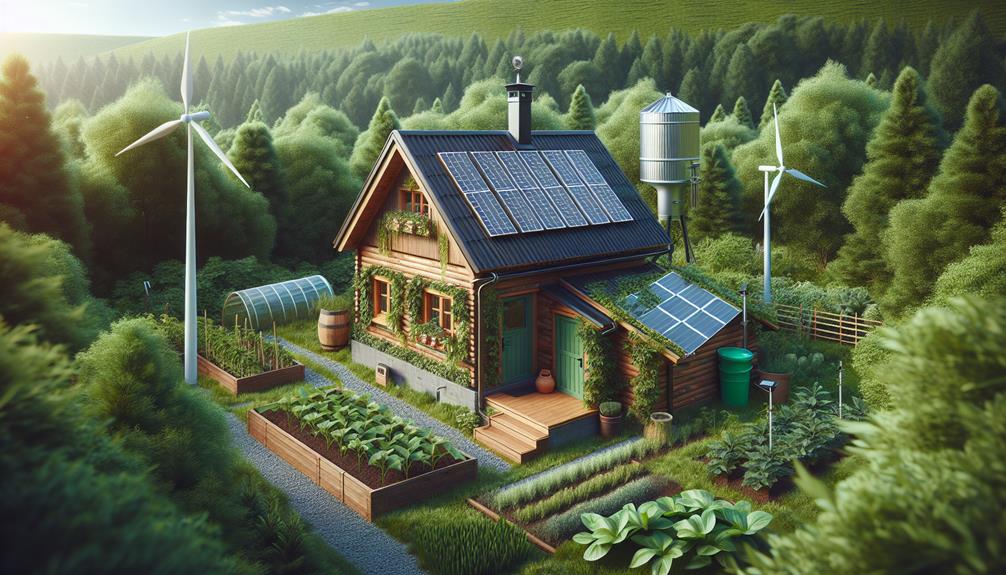As you stand at the precipice of change, the idea of creating a sustainable tiny home might seem like a drop in the ocean, but every drop counts. You're embarking on a journey that melds innovation with simplicity, carving out a living space that not only fits your needs but also treads lightly on the Earth.
To make this vision a reality, you'll need to consider a variety of eco-friendly tips that can turn a small dwelling into a bastion of sustainability. From selecting materials that whisper to the environment rather than shout, to harnessing the sun's generous energy, every choice you make has far-reaching implications.
Ensuring your tiny home is as green as it is cozy requires a thoughtful approach, one that balances comfort with conservation. Stay with me as we explore how to create a space that doesn't just exist for today, but contributes to a healthier tomorrow, and discover why the smallest homes often have the biggest impacts.
Key Takeaways
- Prioritize the use of sustainable materials like reclaimed wood or bamboo.
- Install renewable energy systems such as compact solar panels and solar water heaters.
- Implement water-efficient practices like low-flow fixtures and greywater systems.
- Choose eco-friendly insulation materials and energy-efficient appliances.
Selecting Sustainable Materials
When building your tiny home, always prioritize the use of sustainable materials. This includes options like reclaimed wood or bamboo, which can help lessen your environmental footprint. Opting for eco-friendly tiny home components not only conserves fewer resources but also sets a precedent for responsible living.
Integrating recycled glass into your design can add a touch of unique aesthetics that's also environmentally friendly. By choosing materials like bamboo and natural linoleum, you're investing in renewable resources that promote a healthier planet.
It's important to remember that every element counts when it comes to sustainability. Installing solar panels that harness renewable energy and using low-flow water fixtures for an energy-efficient lifestyle are just a few examples. Supporting local businesses by sourcing nearby also cuts down on emissions, further rounding out your commitment to sustainability.
Incorporating Renewable Energy
Harnessing solar power for your tiny home's energy needs not only slashes utility bills but also reaffirms your commitment to a sustainable lifestyle. Imagine reducing your energy consumption to a bare minimum, thanks to the sun's abundant rays. With the right setup, you can store energy for days when the sun plays hide and seek.
- Install a compact solar system tailored to your tiny home's dimensions.
- Use solar panels to generate and store energy for backup power.
- Opt for a solar-powered ventilation system to use less energy for cooling.
- Invest in solar water heaters to significantly reduce energy costs.
- Incorporate energy-efficient appliances designed for optimized solar power use.
These eco-friendly tips ensure you're at the forefront of innovation, living a life that's both sustainable and technologically savvy.
Maximizing Water Efficiency

To maximize water efficiency in your tiny home, consider installing low-flow fixtures that significantly reduce water usage without compromising performance. By using eco-friendly appliances, such as water-efficient dishwashers and washing machines, you'll need less energy than regular models and help save precious resources.
Implement a greywater system to repurpose water from sinks and showers, cutting down on your consumption. An average tiny home has less space, which means you can produce less waste and manage resources more sustainably.
Adopt a composting toilet to further your eco-friendly tips; it uses minimal water and transforms waste into usable compost.
Don't forget to fix leaks quickly and take shorter showers to ensure you're maximizing water efficiency in every aspect of your sustainable tiny lifestyle.
Insulating for Energy Conservation
Ensuring your tiny home is well-insulated can dramatically reduce your energy bills and enhance your living comfort while shrinking your ecological footprint.
Optimal insulation is key to energy conservation, helping you maintain a cozy atmosphere during winter and a cool retreat in the summer without over-relying on heating and cooling systems.
- Wrap your tiny home in a blanket of sustainable sheeps wool insulation, a natural fiber that breathes.
- Install multi-layered, high-performance windows to trap energy inside.
- Insulate floors with eco-friendly materials that require fewer resources to produce.
- Seal all potential air leaks with green sealants to maintain a controlled climate.
- Choose recycled cotton batts for a non-toxic, low-impact solution that supports energy efficiency.
Embrace these eco-conscious choices to minimize your carbon footprint and live sustainably in your tiny haven.
Choosing Eco-Friendly Appliances

You'll want to select appliances for your tiny home that not only fit your space but also reduce your carbon footprint. Energy-efficient models can slash your utility bills and are designed to work seamlessly in compact living environments.
Prioritize appliances that offer both functionality and sustainability, ensuring your tiny home remains eco-friendly.
Energy-Efficient Appliance Selection
Selecting appliances with high Energy Star ratings is a pivotal step in reducing your tiny home's electricity usage and environmental footprint. When you choose the right energy-efficient appliance selection, you're not only tailoring to your eco-friendly tiny house ethos but also ensuring that your overall energy consumption is less than the average American home.
LED light bulbs, for example, can help you save substantially on utility bills.
- Compact refrigerators that sip power more delicately than their full-sized counterparts
- Conduction cooktops that heat faster and use less energy
- High-efficiency washers that require less water and less power to clean
- Solar-powered chargers to power your home devices with renewable energy
- Smart thermostats to optimize heating and cooling, trimming your energy use
Compact Appliance Benefits
While high Energy Star ratings are crucial for your appliances, opting for compact versions can further amplify your tiny home's sustainability and cost-effectiveness. Compact appliances are designed to fit seamlessly into your small house, allowing you to use less space and power without sacrificing functionality. They're energy efficient, which means they produce fewer emissions and lower maintenance costs over time.
Here's a quick look at compact appliance benefits:
| Benefit | Compact Appliance | Traditional Appliance |
|---|---|---|
| Space | Maximizes layout | Often bulky |
| Energy | Uses less power | Higher consumption |
| Cost | Lower bills | Increased expenses |
| Eco | Fewer emissions | Larger footprint |
Landscaping With Nature in Mind
To create a sustainable tiny home, consider landscaping with native plants and drought-resistant varieties that thrive with minimal intervention and conserve water. Implementing eco-friendly tips not only helps the environment but also enhances your tiny living experience. Here's how you can make your home more sustainable:
- Integrate a drip irrigation system to minimize water waste.
- Enrich the soil with organic fertilizers and establish a composting system for waste.
- Avoid harsh chemicals by choosing organic pest control methods.
- Design outdoor spaces that serve as extensions of indoor living, promoting relaxation and natural lighting.
- Select plants that attract pollinators, supporting biodiversity and local ecosystems.
Each step you take is a stride towards an Eco-Friendly lifestyle that respects nature's rights reserved.
Frequently Asked Questions
How Can We Make Tiny Homes Sustainable?
To make homes sustainable, you'll need renewable energy, like solar panels, green roofs, and sustainable insulation. Opt for water conservation methods, recycled materials, energy-efficient appliances, composting toilets, natural lighting, and passive heating.
How to Build a Small Eco Friendly House?
You'll find that incorporating passive design and natural lighting in your small eco-friendly house greatly reduces energy needs. Also, prioritize green insulation, Energy Star appliances, and reclaimed materials for maximum sustainability.
How Can I Make My Home More Green or Sustainable?
To make your home greener, install solar panels, use Energy Star appliances, and opt for bamboo flooring. Add a living roof, a composting toilet, and harvest rainwater. Don't forget LED lighting and green insulation.
What Changes Can Use Just to Make Your House Eco Friendly?
You can conduct an energy audit, install solar panels, and use a composting toilet. Opt for bamboo flooring, green insulation, and LED lighting. Set up rainwater harvesting and natural ventilation, and choose upcycled furniture.
Conclusion
In the end, your tiny home will stand as a beacon of sustainability, a veritable fortress against wastefulness. By handpicking renewable materials, harnessing the sun's boundless energy, and treasuring every drop of water, you've crafted a haven that whispers to the earth's rhythm.
Snug within your well-insulated walls, surrounded by nature-kissed landscapes, you'll live large in your eco-paradise, proving that the smallest footprints often leave the deepest impressions.
Welcome to the future—your future.

